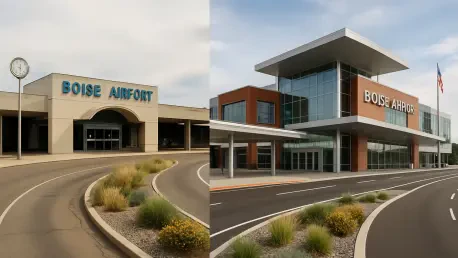Imagine a bustling regional airport struggling to keep pace with an unprecedented surge in travelers, where nearly 5 million passengers passed through its gates in a single year, and Boise Airport, a critical hub for the Treasure Valley, faces this exact challenge as passenger traffic continues to soar. With a monumental $700 million contract awarded to Hensel Phelps by the City of Boise, a transformative overhaul is underway to address these demands. This roundup gathers insights, opinions, and perspectives from industry professionals, local stakeholders, and infrastructure experts to explore how this ambitious project will reshape the airport and what it means for regional growth and national airport trends.
Unpacking the Boise Airport Overhaul: Why It Matters
The scale of the Boise Airport project has sparked widespread interest among aviation and construction circles. Industry observers note that Hensel Phelps, a seasoned contractor with a robust portfolio, is tasked with modernizing a facility that has become a linchpin for Idaho’s economic connectivity. The $700 million investment signals a commitment to not just keeping up with current demand but preparing for future growth, a point emphasized by many in the field as essential for smaller airports aiming to compete on a larger stage.
Beyond the numbers, the urgency of this transformation resonates with local communities and businesses reliant on efficient air travel. Commentators from regional development sectors highlight that with passenger numbers climbing steadily, the airport’s role in supporting tourism and commerce cannot be overstated. Some suggest that without such upgrades, Boise risks losing ground to other Western hubs that are also ramping up their infrastructure.
This discussion sets the stage for a deeper look into the specifics of the project. Various sources weigh in on Hensel Phelps’ approach, the innovative methods being employed, and how this endeavor fits into broader patterns of airport modernization across the United States. The consensus points to a pivotal moment for Boise, with potential lessons for other cities facing similar pressures.
Breaking Down the Boise Airport Project: Hensel Phelps’ Impact
Expanding Facilities with Concourse A and More
At the heart of the Boise Airport upgrade lies the construction of Concourse A, which will add up to 10 new gates to accommodate growing passenger volumes. Aviation planners consulted on similar projects stress that this expansion is a game-changer, allowing for more flights and better service options. The focus on scalability, they argue, ensures the airport can handle spikes in demand without compromising traveler experience.
Supporting this expansion are critical upgrades like a new baggage handling system and a central utility plant. Infrastructure analysts point out that these behind-the-scenes improvements are just as vital as visible expansions, directly addressing bottlenecks that frustrate passengers. With nearly 5 million travelers recorded recently, the strain on existing systems has been evident, making these enhancements a priority in expert discussions.
However, not all opinions align seamlessly. Some construction managers caution that building in an active airport environment poses unique challenges, from minimizing disruptions to ensuring safety. While short-term inconveniences are inevitable, many agree that the long-term benefits—such as improved efficiency and capacity—far outweigh the temporary hurdles, a balance that continues to spark debate among stakeholders.
Addressing Capacity for Boise’s Rapid Growth
Terminal enhancements, rolled out in two distinct phases, aim to streamline passenger flow and boost overall capacity at Boise Airport. Urban development specialists note that this phased approach reflects strategic foresight, allowing adjustments based on real-time needs and feedback. The focus on flow optimization is seen as a direct response to the region’s booming population and economic activity.
Many draw parallels between this initiative and other regional airport expansions, citing the BOI Upgrade capital development program as a benchmark for planning. Industry voices argue that Boise’s model could inspire similar-sized airports to tackle growth proactively. The emphasis on capacity is not just about numbers but about positioning the city as a competitive travel node in the West.
Yet, risks linger on the horizon, as some financial analysts warn of potential delays or budget overruns that could derail progress. On the flip side, optimists in the sector see an opportunity for Boise to leverage these upgrades into a stronger market presence. The divergence in views underscores the high stakes involved, with success hinging on meticulous execution and adaptability.
Aligning with National Airport Modernization Trends
Boise’s project is part of a larger wave of airport upgrades sweeping the nation, with Hensel Phelps playing a leading role in multiple initiatives, such as the $2 billion redevelopment at John Glenn International in Columbus, Ohio. National infrastructure experts observe that this trend reflects a collective push to modernize aging facilities amid rising passenger expectations. The contractor’s involvement across various regions highlights a trusted expertise in navigating complex projects.
Regional differences in infrastructure needs add another layer to the conversation. Some consultants point out that while larger hubs prioritize massive overhauls, smaller airports like Boise can achieve significant impact through targeted investments. This perspective challenges the notion that scale always dictates success, prompting discussions on how tailored solutions might influence future designs.
Speculation abounds on whether Boise’s transformation could set a precedent for funding or planning models elsewhere. A few industry watchers suggest that smaller airports might look to this project as proof that strategic upgrades can yield outsized returns. The debate remains open, with varying opinions on whether such localized efforts can truly reshape national priorities in aviation infrastructure.
Leveraging Collaborative Construction Approaches
The City of Boise’s choice of the construction manager/general contractor (CM/GC) delivery method has drawn attention for its emphasis on partnership and early contractor involvement. Construction industry leaders praise this model for fostering cost control and flexibility, especially in projects as intricate as airport expansions. The approach is seen as a way to mitigate risks that often plague large-scale public works.
Comparisons to traditional methods reveal stark contrasts, with many project managers arguing that CM/GC offers superior adaptability over rigid frameworks. Municipal officials from other cities, reflecting on their own infrastructure challenges, note a growing preference for such collaborative setups. This shift, they contend, stems from a need to balance tight budgets with ambitious goals, a sentiment echoed across the sector.
Looking ahead, some speculate that this trend could redefine how public infrastructure is developed, particularly for aviation projects. Insights from policy advisors suggest that Boise’s adoption of CM/GC might encourage other municipalities to experiment with similar models. The potential for broader industry change adds a compelling dimension to the local story, highlighting a possible evolution in construction practices.
Key Takeaways from Diverse Perspectives
Synthesizing the range of opinions reveals several core insights about the Boise Airport transformation. The urgent need for capacity expansion stands out as a unifying concern, with nearly all sources agreeing on the importance of meeting current and projected passenger growth. Hensel Phelps’ track record in handling major airport projects also garners widespread confidence among industry professionals.
Another recurring theme is the value of innovative delivery methods like CM/GC. Stakeholders across the board—from contractors to city planners—recognize this approach as a tool for managing complexity and cost. Practical advice emerges from these discussions, with many suggesting that other cities consider similar models to navigate the pitfalls of large infrastructure investments.
For those invested in such developments, whether professionals or local residents, staying informed is crucial. Industry forums and public planning sessions offer avenues to track progress and voice input on projects like Boise’s. Engaging with these resources can help communities advocate for smart, sustainable upgrades that align with long-term regional needs.
Reflecting on the Journey and Next Steps
Looking back, the exploration of Boise Airport’s $700 million overhaul through varied lenses provided a comprehensive understanding of its significance. The dialogue among industry experts, local advocates, and infrastructure analysts painted a vivid picture of a project poised to redefine regional connectivity. The consensus on capacity needs and collaborative methods marked a shared vision for progress.
Moving forward, cities embarking on similar ventures might consider prioritizing early stakeholder collaboration to preempt challenges. Exploring case studies from Boise and beyond could offer actionable blueprints for balancing growth with operational continuity. These steps emerged as practical takeaways from the roundup’s insights.
Additionally, keeping an eye on evolving funding mechanisms and construction trends will be vital for sustaining momentum in airport modernization. Communities and professionals alike are encouraged to delve into resources like industry reports or local government updates to stay ahead of the curve. This focus on proactive learning and adaptation shapes a forward-looking path for infrastructure development.









